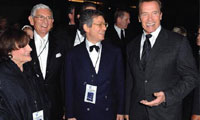 What is the sin MoCA and Jeffrey Deitch have committed?
What is the sin MoCA and Jeffrey Deitch have committed?If Deitch thrives in his new post, I suspect it will go a long way towards silencing the gasps when the next dealer is appointed to head a museum
It is relatively easy to move from the non-profit sector into the commercial side of things, but trying it the other way can be very tricky indeed. Art professionals moving from the commercial sector are widely viewed as more suspect than those moving from one non-profit institution to another.
Before the global economic crisis, the art world saw a number of high-profile defections from non-profit to the commercial sector, including Amin Jaffer, who left the Victoria and Albert Museum, London, to become Christie’s international director of Asian art; Lisa Dennison, who, after 29 years at New York’s Solomon R. Guggenheim Museum (including two years as director), resigned to become executive vice president of Sotheby’s North America, and Emma Dexter, who gave up being the senior curator at Tate Modern to become director of exhibitions at London’s Timothy Taylor Gallery. While these moves raised a few eyebrows, they did not generate anything like the frenzy of speculation that met the recent announcement that New York dealer Jeffrey Deitch had been named as the new director of the Los Angeles Museum of Contemporary Art (MoCA).
Reactions to this selection ranged from Jerry Saltz’s prediction that “scolds will imagine immoral scenarios of a wolf in the fold and tut-tut over the possibility of an uncouth, craven commercial dealer trading museum treasures for market-share, making back room deals and violating ethics” (New York Magazine, 10 January) to Christopher Knight’s expectation that “virtually every planning move its new director makes will raise questions about its relationship to Deitch’s veiled commercial entanglements, which are long-standing and international in scope” (Los Angeles Times, 11 January).
Oddly, the degree of pre-emptive suspicion over such a move seems inversely proportional to how successful the mover has been in the commercial art world. In dismissing comparisons between Deitch and Walter Hopps (who had left Los Angeles’s Ferus Gallery to become curator and eventually director of the Pasadena Museum of Art), for example, Knight wrote that “no one would ever mistake the mercurial Hopps for a sharp businessman”. This suggestion that Hopps’s lack of commercial acumen made him a better choice as museum director is not supported by evidence readily available in Los Angeles.
Former commercial dealer-director Ann Philbin, now director of the Hammer Museum at UCLA, is widely viewed as having transformed that institution from a quiet regional museum into an international destination. Yes, Philbin also served as director of New York’s non-profit Drawing Center before moving to LA, but Deitch (despite widespread insistence that he had no museum experience) has also been a curator at the De Cordova Museum, Lincoln, Massachusetts.
The arts journalist Tyler Green noted in his interview with Deitch just after the announcement (www.artsjournal.com/man/) that there are, of course, ethical considerations that should be addressed by an art dealer taking over the leadership of an art museum. Will he close his gallery? (Yes, on 1 June.) Will he ever return to dealing? (He says, no.) What will happen to his existing programme and artists? (He’s still working that out.) What becomes of his private collection that he has built over the years? (Ahh, that is a murky one and seems to be more ethically difficult than anyone involved in the appointment seemed to have understood. Stay tuned.)
Although Deitch answered each of Green’s questions with an impressive forthrightness, a survey of the comments on arts and mainstream media websites suggests there is a segment of the population for whom no measure of good faith or planning on MoCA’s or Deitch’s part could erase their reservations. Partly, the long-standing relationships between Deitch, his artists and the museum’s board—especially super-collector and MoCA trustee Eli Broad—make answering the question of whether the dealer was selected solely on his qualifications nearly impossible to answer to everyone’s satisfaction. Then there are the speculations and suspicions about why Deitch would ever consider such a move in the first place. He told Green it was to “serve a much larger, diverse audience” than he had in his gallery, but, during a public panel discussion at the X Initiative last autumn in New York, Deitch did say that, if things continued the way they were going, he didn’t see how his gallery could survive more than two years. Every gallery was uncertain then, but that comment still reverberates.
Whether the downturn in the art market will encourage more movement from the commercial into the non-profit sector remains to be seen, but, if Deitch thrives in his new post (and he has a very good record in each new ring he’s thrown his hat into), I suspect it will go a long way towards silencing the gasps when the next dealer is appointed to head a museum.
The writer is the owner-director of the Winkleman Gallery, New York, and writes for www.artworldsalon.com as well as his own blog,
 What is the sin MoCA and Jeffrey Deitch have committed?
What is the sin MoCA and Jeffrey Deitch have committed?